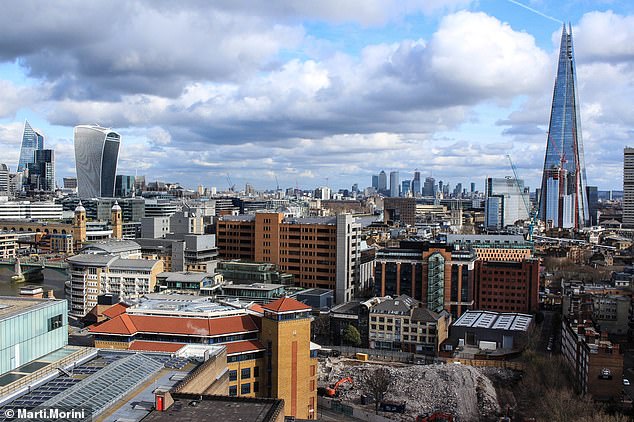
PAINTING LONDON'S ROOFS WHITE 'COULD KEEP US COOL DURING HEATWAVES'
- Roofs painted with a white surface could better prepare London for heatwaves
- READ MORE: Brits may need to work earlier to avoid 'uncomfortable' heat
Scientists already think that London is unprepared for hotter temperatures in a future hit by climate change.
That's because the city's buildings and infrastructure have historically been built to retain heat, not release it.
But experts may have identified the best available solution – painting all of the city's roofs white to reflect sunlight.
The scientists at University College London say white roofs would cool the city more effectively than solar panels or 'green roofs' that are covered with plants.
Some of the world's whitest paints reflect nearly all sunlight, meaning buildings absorb less solar energy and in turn are cooler.
The new study was led by Dr Oscar Brousse, a climate scientist at UCL's Bartlett School Environment, Energy and Resources.
'We comprehensively tested multiple methods that cities like London could use to adapt to and mitigate warming temperatures,' he said.
'[We] found that cool roofs were the best way to keep temperatures down during extremely hot summer days.
'Other methods had various important side benefits, but none were able to reduce outdoor urban heat to nearly the same level.'
Roofs painted white, also known as 'cool' roofs, can be already found in nations that have been historically hotter than the UK, but overall there is a lack of 'cooling strategies' as the debate over their effectiveness is 'currently ongoing'.
To find out more, the team used an urban computer model to conduct 3D simulations of extreme heat in Greater London.
Temperatures in the simulation were set to the two hottest days of summer 2018, when the British Isles endured a blistering heatwave that caused drought, hosepipe bans, crop failures and wildfires.
'The model represents the impact of buildings and streets in three dimension and considers the interactions between the indoor and outdoor environments.' Dr Brousse told MailOnline.
On average, white roofs most effectively reduced London's temperatures, by around 2.16°F (1.2°C).
White roofs had greater cooling power than solar panels (which had a reduction of around 0.9°F/0.5°C), as well as 'street level vegetation' such as trees and bushes (0.54°F/0.3°C).
And although green roofs offer benefits like water drainage and wildlife habitats, their average net cooling effect on the city was found to be zero.
Meanwhile, air conditioning – which transfers heat from within buildings to the outside – would warm London by about 0.27°F (0.15°C) for the city overall, but by as much as 1.8F (1°C) in dense central London.
However, the team add that solar panels could potentially provide sufficient energy for running air conditioning all over London to create 'comfortable indoor environments'.
As the climate changes, residents within cities are particularly vulnerable to warming temperatures – not just London but many densely-packed cities including Paris, Beijing and Los Angeles.
Cities generally trap heat, inducing the urban heat island effect that can lead to greater discomfort and death.
'During hot spells, higher mortality and increased likelihood of thermal discomfort are generally observed,' the team say in their study, published in Geophysical Research Letters.
Last year, a report found at least 61,000 people died across Europe in summer 2022 due to heatwaves, including 3,469 in the UK.
Read more 2024-07-05T13:33:47Z dg43tfdfdgfd